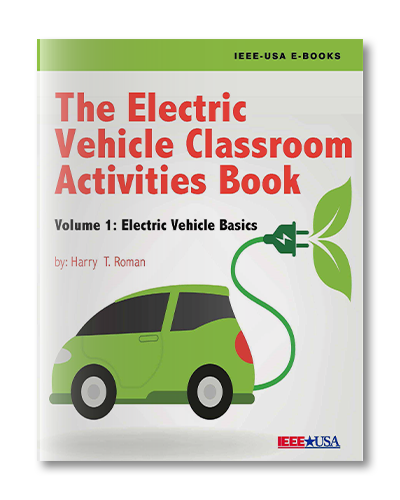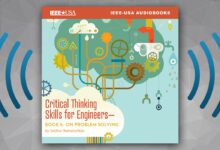

The Electric Vehicle Classroom Activities Book – Vol. 1: Electric Vehicle Basics
FREE to IEEE Members
Non-Members: $2.99
IEEE-USA has published the first in a new, two-book series by author Harry T. Roman — to help educators as they lead their students in exploring electric car technology. The Electric Vehicle Classroom Activities Book – Volume 1: Electric Vehicle Basics provides teachers with discussion ideas surrounding the history of electric cars; and he delves into three areas: the operation of electric cars, electric car batteries and electric car charging. This book can provide a starting point for drafting lesson plans to help ground students in one of the most important innovations taking place in today’s marketplace. Roman also has a second volume to follow, Fascinating Electric Vehicles Activities, also to be published by IEEE-USA.
“All technologies have pros and cons, and electric vehicle technology is no different. It is my hope this small volume will stimulate informative exchanges among our future leaders,” Roman writes, in the introduction to the book.
Roman starts his history of electric cars in the mid-1800s, talking about bicycles. He explains that early “cars” were called “quadracycles”— two bicycles joined together. He points out that electric cars are not new: in 1899, 38 percent of the cars were electric, second only to steam-powered cars, and ahead of gasoline-powered vehicles. Of course, there were only 8,000 cars on the road at the time.
According to Roman, early electric car sales peaked around ten years later, in 1910, with more than 30,000 electric vehicles registered in the United States. While numerous electric car companies sprang up around the country, none could compete with Henry Ford’s Model T. The Model T was cheaper, less expensive to fuel and, as gas stations proliferated, could go great distances in a vast country. The electric car became a dinosaur — but not one destined for extinction. After a few false starts, electric cars are back — and growing rapidly in popularity.
Roman suggests teachers have students explore how the early electric cars developed, who designed them, what logos they used, how much they cost (compared to Ford’s Model T), and what types of batteries were used (and how they differ from those used today).
Roman proposes that students talk to parents or grandparents about how cars have changed in their lifetimes, and what additional changes electric cars might bring. Other areas he suggests exploring include:
- How do the models available today differ from each other?
- Why are some countries adopting electric cars faster than others? What role do incentives offered by different governments play in differing adoption rates?
- How does the United States compare to other countries? Which country has the highest percentage of electric cars sales, or the most electric cars on the road?
- What is regenerative braking, and why is it important?
- How do fully electric vehicles, plug-ins, and hybrids differ? Roman suggests asking the students to think about which one might be best for their family.
While Roman points out that batteries are not unique to electric cars (gasoline-powered cars need them for starting), clearly innovation in batteries is a major factor driving the growth in electric car sales around the world. Roman recommends that teachers guide students to explore early batteries; how to make a simple battery in the classroom; the role of electrolytes in batteries; the difference between dry and wet batteries; and what innovations are currently being explored to make batteries in electric cars even better.
Roman then looks at electric charging stations. He draws on his extensive knowledge of Thomas Edison, pointing out that Edison was not only active in developing the electric car, but he also installed the first residential charging station at his home in West Orange, NJ (where visitors can still see it). Roman’s activities surrounding charging include having students investigate the pros and cons of slow and fast charging, evaluating the cost of getting a garage “charger ready,” and brainstorming how to design charging for apartment dwellers.
Electric Vehicle Classroom Activities Book – Volume 1: Electric Vehicle Basics is available to IEEE members for free at IEEE-USA’s online shop and is available for non-members for $2.99.
Just as Henry Ford disrupted the car industry in the 1900s, Tesla CEO Elon Musk, continues to disrupt the car industry this century with his fully electric-powered car. Suitably, Roman chooses to end his book with a collection of quotes from Musk.
Harry T. Roman holds 12 US patents and has received numerous engineering, invention and teaching awards. The New Jersey Inventors Hall of Fame honored him with an Inventor of the Year award for his application of mobile robots in hazardous work environments, and IEEE honored Roman with a Meritorious Achievement Award, for developing continuing education products for IEEE members. Roman currently teaches a graduate course at Montclair State University on applying STEM techniques in the classroom. He is an advisor/author to the Edison Innovation Foundation, and docent/special lecturer at the Thomas Edison National Historical Park, in West Orange, NJ.
Paul Lief Rosengren is the coauthor of In the Time of COVID: One Hospital’s Struggles and Triumphs, which received a 2021 Best Independent Book Award in the medical category and Hedy Lamarr – Inventor Extraordinaire and Hollywood Star, published by IEEE. He has a Masters in Public Policy from The Kennedy School of Government, Harvard and an undergraduate degree in political science from Dickinson College.






